A McDonald's get McBoxed, but a classic sign (and Ronald) survive; the roadside gems of New Haven; a pay phone sign becomes a subway museum piece
Plus, meet the man behind an astonishing World's Fair collection; a gorgeous Route 66 sign will get restored; a vanished California drive-in will be rebuilt; and more headlines from the American road.
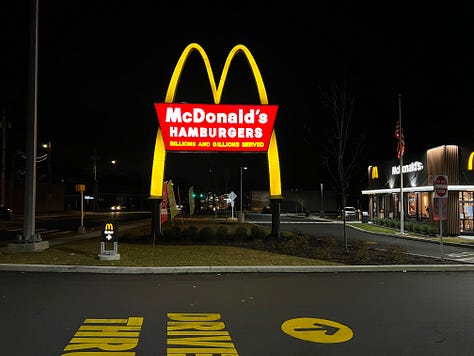
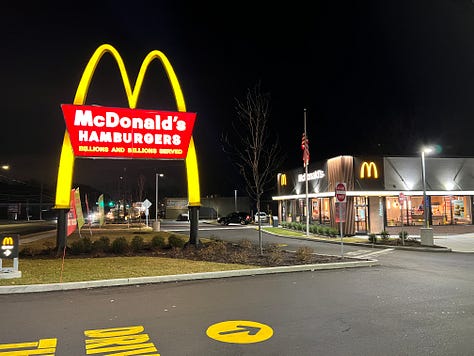
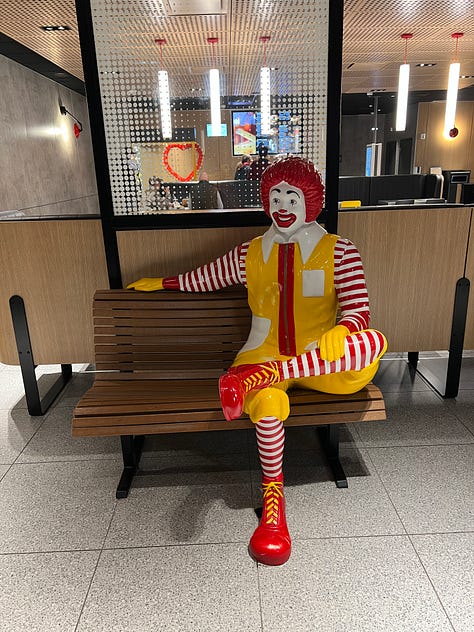
Back in March 2022, I brought you the news on my Instagram page that the old-school McDonald’s in Milford, Connecticut, was about to be demolished.
As I wrote last year, “We’ll see how this looks when it’s done. I hope they preserve the sign, and maybe keep a few of the characters for old-time’s sake. But it will never be the same.”
Well, that’s more or less what happened.
It has since been replaced with a much smaller building, swapping out the 1972 mansard for the 2022 box, and eliminating what had been billed as New England’s largest McDonald’s PlayPlace altogether.
All that remains of the original complex is the “Big M” sign, which dates to when this McDonald’s first opened in 1966, and, in the lobby, a statue of Ronald McDonald relaxing on a bench.
All the other traces of the McDonaldland era, which you can see in my photo gallery, below, are gone.
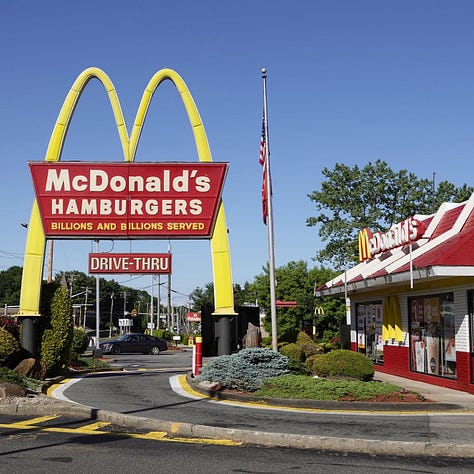
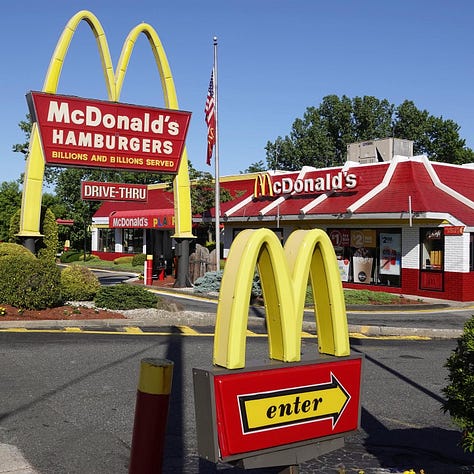
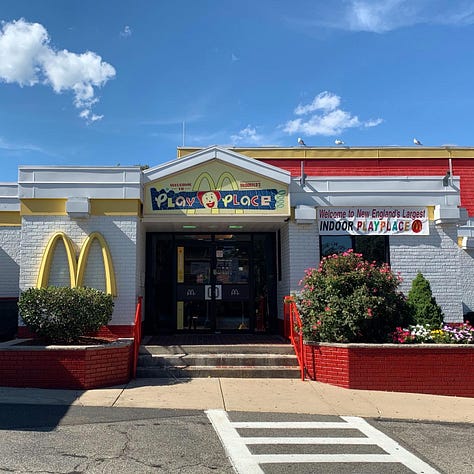
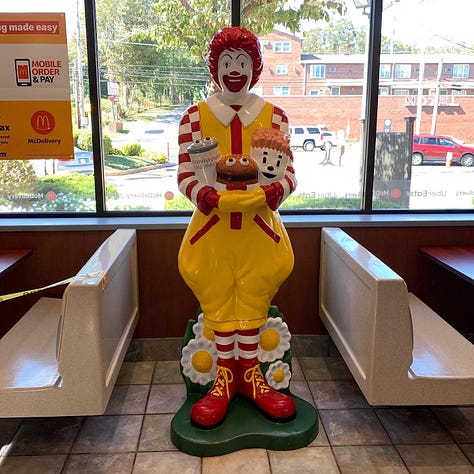
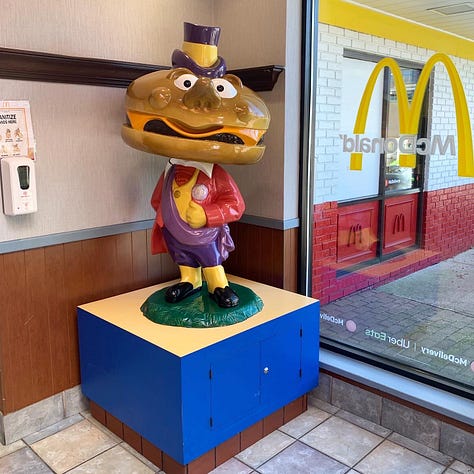
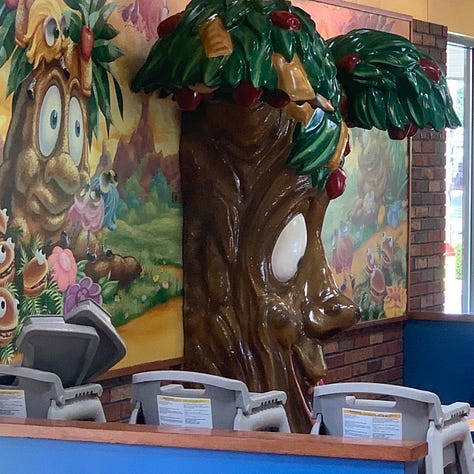
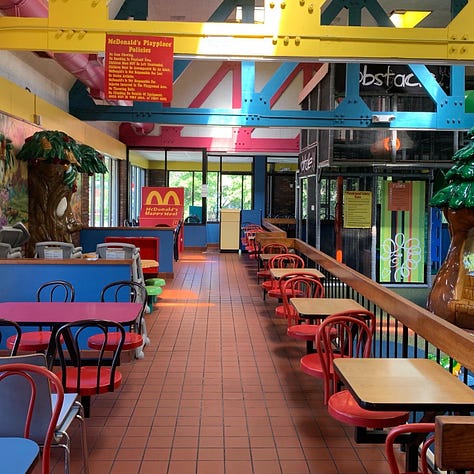

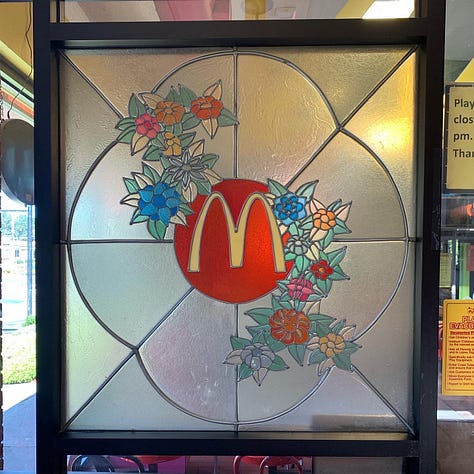
As I told you last year, this location, at 439 Bridgeport Ave., opened in May 1966, with the sign the only holdover of that period. The original structure, likely a slanted red-and-white building flanked by arches, was replaced by a mansard just six years later, as this McDonald’s held a grand reopening celebration starting Tuesday, Oct. 24, 1972. Ronald himself appeared in person to herald the new era on Saturday, Oct. 28.
Additional renovations followed in future years, but they still preserved the traditional mansard building.
My last visit before the latest renovation was in September 2020. I could not believe how intact this restaurant still was, with Mayor McCheese greeting you by the door and the old-school PlayPlace complete with apple trees and those colorful plastic tables and seats McDonald’s was famous for.
On the local Milford Facebook group thread, some felt it was beyond time to renovate, but those voices were outnumbered by nostalgic souls.
Many memories centered on Grimace – and the dangers he posed.
“My brother broke the Grimace once 🤣 he was inside the metal Grimace cage thing rocking it back and forth and the coils on the bottom snapped and it fell over with him inside of it,” wrote one person.
Added another: “I got my head caught inside the round hole of Grimaces hat, and my mom had to call the fire dept.”
Hard to imagine such memorable moments every happening here again.
The Retrologist’s Guide to New Haven, Connecticut | Premium Subscription Feature
On Saturday, I hit the road with a couple of friends to New Haven, Connecticut. We partook in pizza at the great Frank Pepe’s (I did some photographing on Wooster Street while they waited in line outside Pepe’s, part of the ritual of visiting here) and then, I hit the streets of New Haven while they checked out exhibits at the Yale University Art Gallery.
My visit inspired me to put together a selection of places to visit in New Haven, Connecticut, in the post, also linked below, as a service to patrons of my newsletter. Please consider upgrading your subscription for more special articles like this, and thank you for your support of my newsletter!
A museum piece in the subway: A NYNEX public phone sign in Queens, New York
Once upon a time, the Bell System was America’s telecommunication mother.
Reliable old “Ma Bell,” though, got too big, and wasn’t exactly a good sport about allowing competition, and the Feds broke her up into parts. The deal was reached in 1982, and on Jan. 1, 1984, the Bell System (as it was long marketed) was no more.
AT&T was spun off to handle long distance and equipment manufacturing, and local phone service was split into seven holding companies covering the lower 48. Those so-called “Baby Bells” contained within them the legacy local Bell telephone companies. In the Northeast, for example, NYNEX (the region’s Baby Bell) was made up of New York Telephone and New England Telephone, which had been around for almost a century.
Publicly, most of the Baby Bells kept using the names of their old local telephone companies. The breakup was traumatic and confusing enough for customers, and their local phone companies had long been the face of the Bell System — and phone service in all its forms — anyway.
Starting with the breakup in 1984, AT&T was no longer the owner of the local phone companies, and you could get your long distance from AT&T or a competitor like MCI. Local service still came from your local company, but you’d get separate long-distance and local-service bills now.
So, for example, in the Midwest, where Ameritech, that region’s Baby Bell, ruled, a commercial for phone service in 1986 running in Chicago would mention Illinois Bell, and in Detroit, Michigan Bell, and in Cleveland, Ohio Bell. The same went for the logos on phone bills, service trucks, central offices and officer towers.
The Baby Bells did subtly roll out their “new” holding company names as well, linking them to Yellow Pages, early cellular divisions and other niche businesses. Awareness also grew of the holding company name by its subsidiary use in connection with local Bell name. So it was, say, “New York Telephone: A NYNEX Company.”
This changed in the mid-1990s, when most of the Baby Bells went all in on their corporate names, and abandoned the local Bell names. It made marketing easier and cheaper for one thing, and was a way to prepare the companies for the looming millennium. By 1994, New York Telephone seemed like a fusty old name. People were just starting to get dial-up Internet at home, and names like NYNEX and Ameritech seemed more appropriate for the new digital day that was dawning.
In New York, NYNEX has a brief run, however, as the dominant regional phone brand, after New York Telephone branding was retired. NYNEX was used from 1994 to 1997, replaced that summer with Bell Atlantic. Yes, starting in the mid-1990s, the Baby Bells began beefing up, beginning to merge with one another. NYNEX teamed up with Bell Atlantic, which originally covered New Jersey, Pennsylvania, Maryland, Delaware, the District of Columbia, Virginia and West Virginia.
Bell Atlantic was deemed the better name, and so, starting in August 1997, NYNEX was dead. In 2000, when Bell Atlantic merged with GTE and begat Verizon, Bell Atlantic was dead, too.
One of the things I like to do is look for traces of our telecommunications past. NYNEX did a good job of switching over most public-phone signage to its brand, replacing the earlier New York Telephone, between 1994 and 1997. Yet, here and there, in the year 2023, you will still find a trace of those three years of NYNEX.
This photo shows a flanged sign for NYNEX that has been left in place at the 36th Street subway station in Queens, a curiosity for commuters who have the ability to stop staring at their smartphones for more than a second or two and look at what’s around them.
There is no public phone nearby. Verizon got out of that business about a decade ago, and the last proper street payphone in New York City was removed in Midtown last year. (There are Superman-friendly exceptions, though, and I will cover those in a future post.)
Still, I love how this NYNEX sign remains, an enigma for some, a throwback for others, but a museum piece for all.
Notes From the Road
For New York World’s Fair fans, this Bowery Boys podcast episode is a must listen, featuring an interview with my friend Kyle Supley, cultural historian and tour guide extraordinaire whose impressive collection of World’s Fair memorabilia is on permanent exhibition at the City Reliquary in Williamsburg, Brooklyn. The City Reliquary, which I support monthly, is so worth a visit, by the way! [Bowery Boys]
I told you in a recent newsletter that Things Remembered would likely soon be a memory — a “thing remembered,” I suppose. Well, it appears the end has come for the mall standby, which first opened a store in 1967. I think I had last stopped in one to get a fancy pen engraved — in 1991. Did you shop at Things Remembered? [Newsday]
The beloved WECO sign in West Columbia, South Carolina, was removed last year for refurbishment. On Tuesday, Jan. 10, it will be relit in a ceremony. Details here. And earlier coverage here. H/T Debra Jane Seltzer.
McDonald’s has announced layoffs among its corporate staff, the latest large corporation to do so. The company’s CEO said the Golden Arches plans to open more stores to keep up with demand. McDonald’s has been a sales “star” of the pandemic and now these inflationary times. [ABC7NY]
A major Burger King franchisee, TOMS King, with restaurants in states like Ohio and Pennsylvania, has announced it is seeking Chapter 11 bankruptcy protection, reeling from reduced pandemic-era foot traffic, inflation and labor shortages. [WKYC]
After a public outcry, the classic hat sign has returned to an Arby’s in Meadville, Pennsylvania. [ErieNewsNow] [Retrologist Arby’s coverage]
Northlake Tavern and Pizza House in Seattle will be closing after 65 years, as the owner who learned the trade from the restaurant’s founder announced he was retiring. [Northlake Tavern and Pizza House on Facebook]
Barnes & Noble is closing its Paramus, New Jersey, store after 28 years, not long after shutting its space in Clark. B&N says it hopes to find new locations for those stores soon. [NJ.com]
Altmeyer’s, the bankrupt 82-year-old home-good chain in Pennsylvania, has begun a liquidation sale. [TribLive]
The historic Hi-Way Cafe on Route 66 has removed its neon sign, but fear not. It’s being refurbished! This sign, in Vinita, Oklahoma, is one of my favorite signs on the Mother Road — frankly, anywhere! I photographed it in June 2013, during my Prairie-to-the-Pacific road trip of all of Route 66. [Hi-Way Cafe on Facebook]
The Highland Park Theater in Los Angeles is reportedly closing next month. [L.A. Taco]
And more sad theater news: The Ken Cinema in San Diego has been sold and remains closed. [KPBS] H/T John Ruzicka
On the matter of closed theaters, back in December, on one of the coldest days in Atlanta in years, I got to visit the beloved Tara Theatre, which closed last year. I was absolutely smitten by its circa-1970 charms.
There are serious concerns about the future of the former Bowlero at the Scottish Rites Center in San Diego. [Adriene Biondo on Instagram]
The Ben Franklin in Fayetteville, West Virginia, is closing after nearly 70 years. I love a good Ben Franklin, and this is really sad. [Lootpress]
Herb Permillion, the gifted typewriter repairman featured in the documentary “California Typewriter,” has died. I really enjoyed this film about the now-defunct typewriter repair shop in Berkeley, and I strongly suggest you seek it out, if anything to see the great Permillion in action. [SF Chronicle/Paywall][California Typewriter]
Speaking of great typewriter repair shops, I recently assigned a profile of the Gramercy Typewriter Co. in Manhattan, which is now based in Chelsea. Its small showroom doubles as a museum, and unlike a museum, you can actually buy the pieces on display, or drop off your own for expert repair. Enjoy this video report by my colleague Brittany Winderman. [ABC7NY]
The Commack Motor Inn, a no-tell motel on Long Island, has been sold for almost $14 million, and the new owner reportedly wants to spiff up the place and make it family friendly, eliciting approving nods from neighbors. [News12]
Historic building catches fire in Enfield, Connecticut. [ctpost]
The Hotel Chelsea celebrates its reopening. I’ve already been to the reimagined El Quijote restaurant there, and need to get back soon. [PIX11]
A family is determined to rebuild a replica of the former Mearle’s College Drive-in in Visalia, California. [Sun Gazette][PBS documentary]
NOTE: Do you enjoy and find value in my newsletter? Please consider supporting it by becoming a paid subscriber!


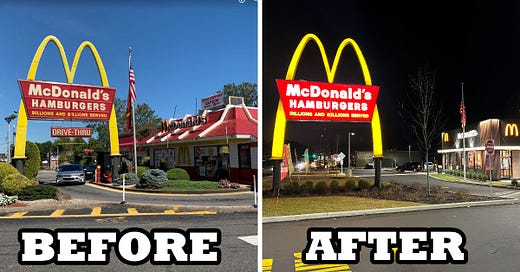


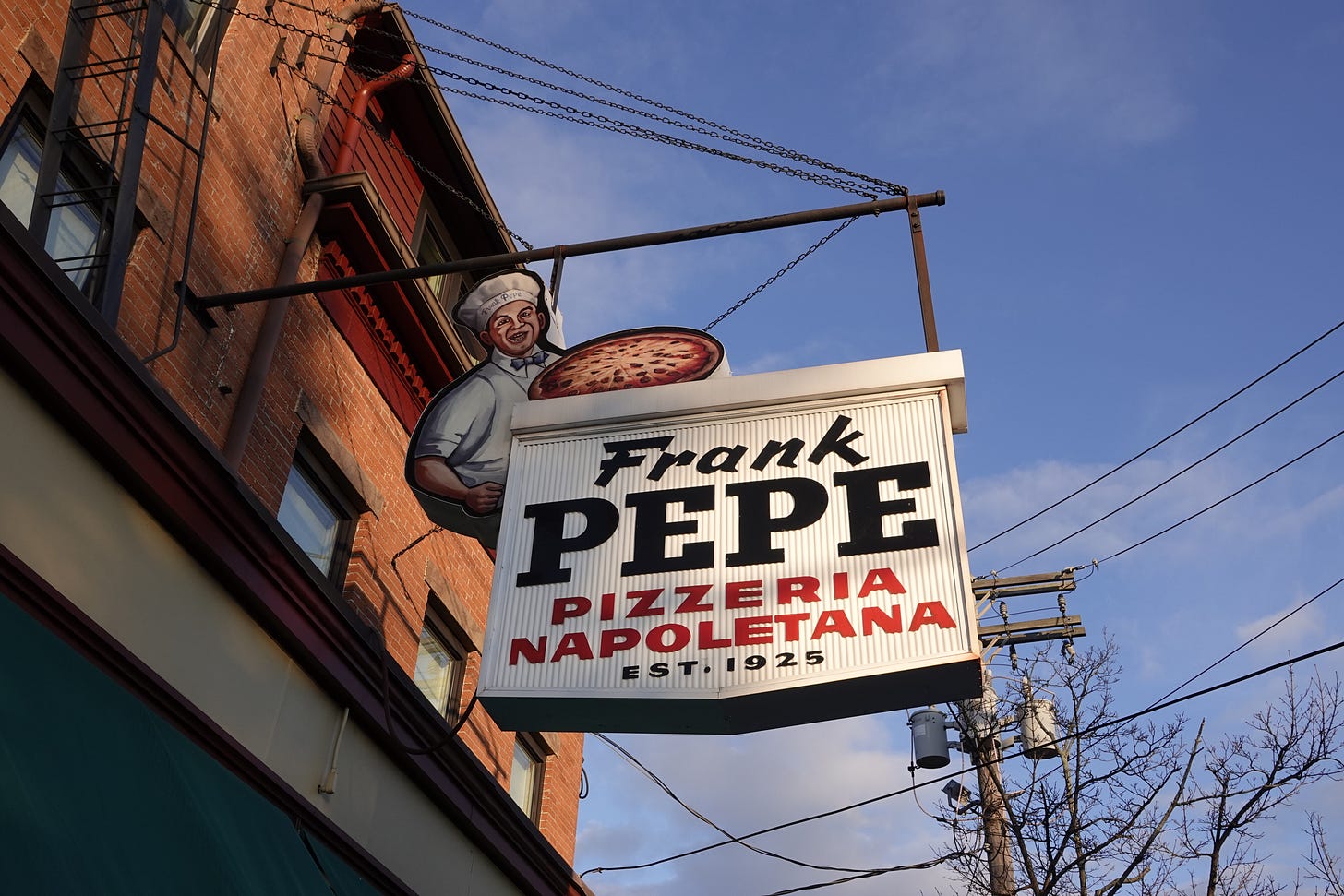
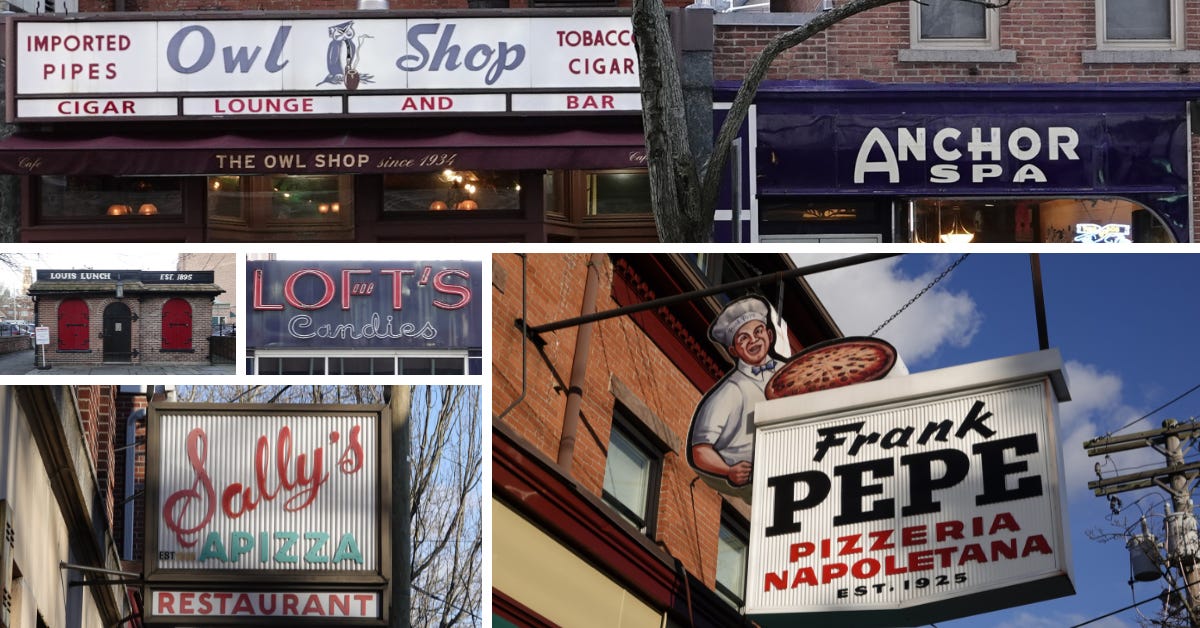


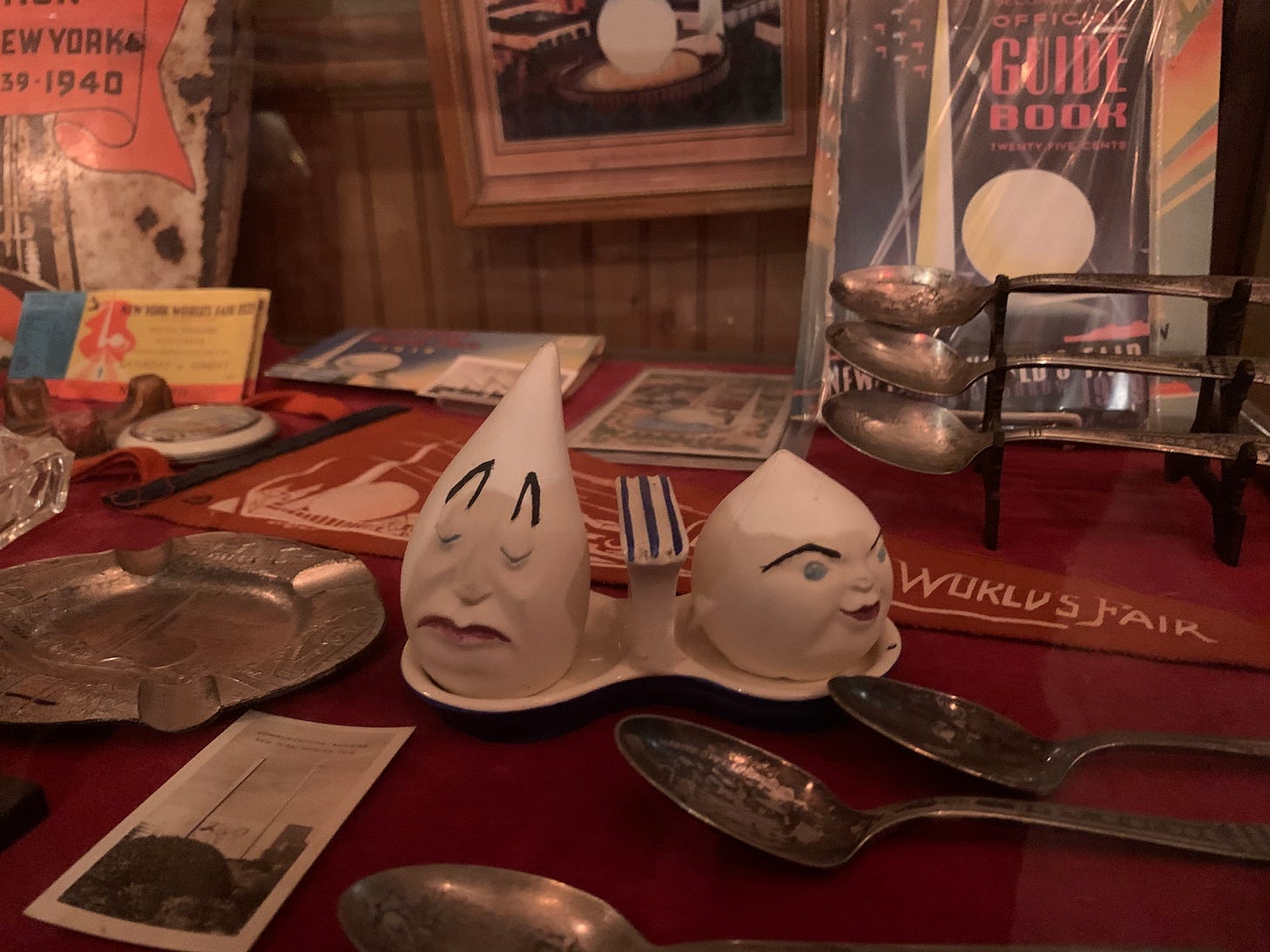


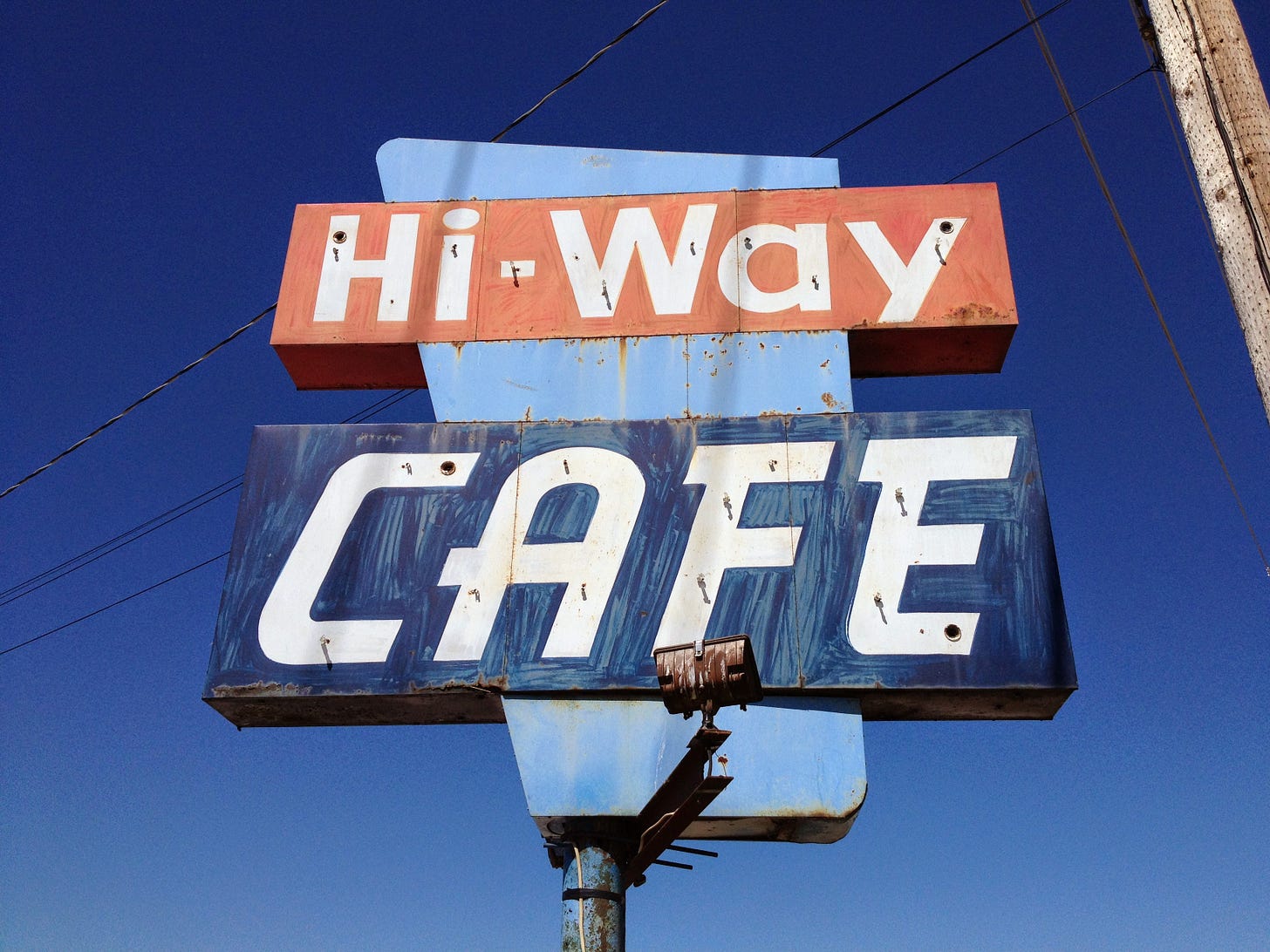


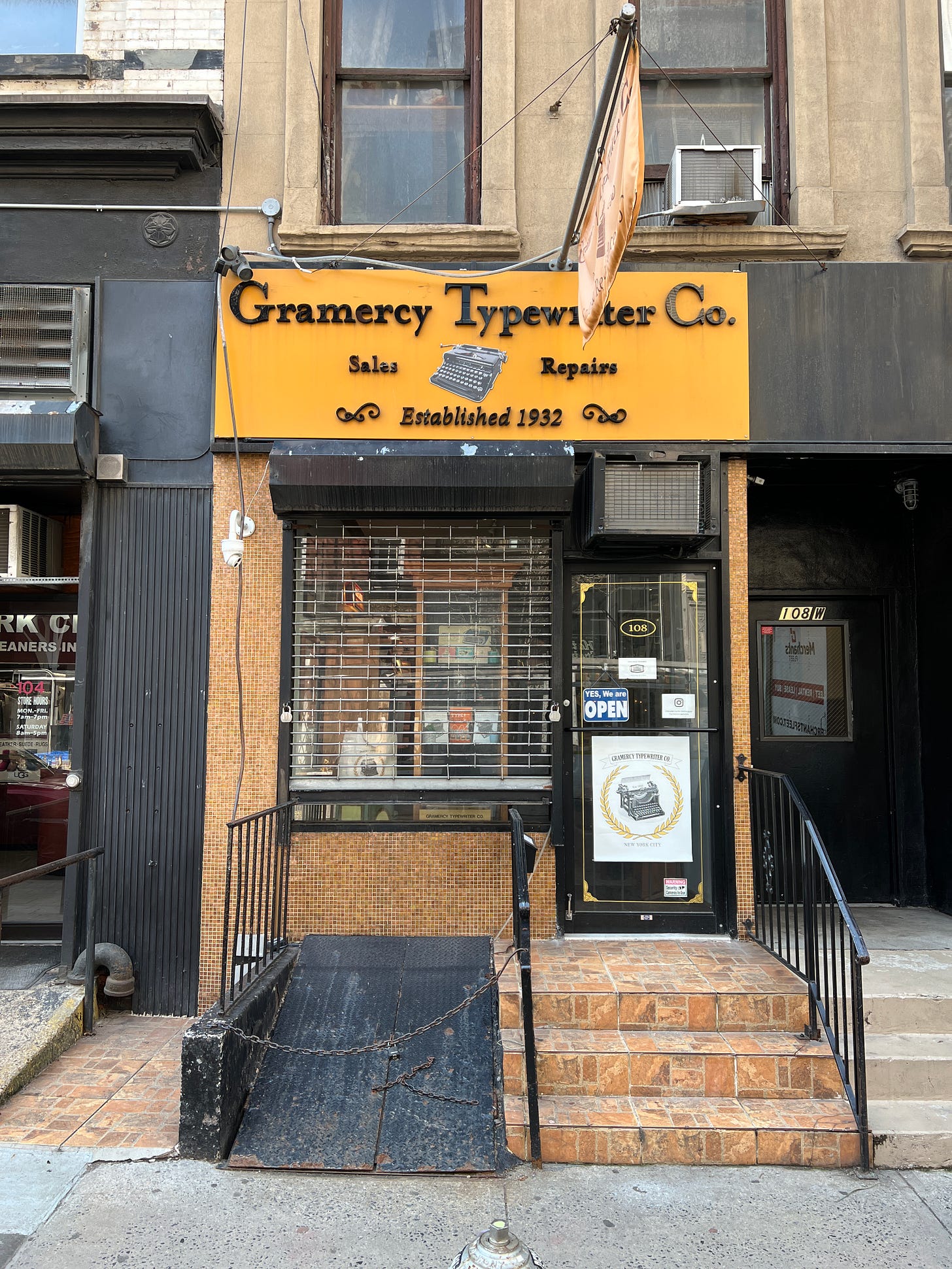
Hi,
Talk about Retro! Here are some comments I just made at the "Marginal Revolution" blog:
Mark Bahner
2023-04-25 12:40:30
When I was maybe 8 years old, McDonald's were all strictly "drive-in" places. There were no tables for eating inside any McDonald's and people would typically eat in cars in the parking lot.
One time, my dad was ordering, and my mom and us kids and our dog were in our station wagon. Then, someone in a car right next to ours opened the driver's side window and just threw a bag filled with cups and wrappers onto the sidewalk. This was even though, as I remember it, a trash can was in plain view of this car, less than 30 feet away.
So I got out of our station wagon, walked over and picked up the bag, and knocked on the window. The driver rolled down the window, and cigarette smoke poured out as he and his girlfriend sat there. I remember he had facial hair...a mustache and perhaps a two-day growth on his chin. I said, "You dropped this."
He said, in a very surly voice, "So?"
I'm not sure I said anything about the trash can right next to his car. I think I may have. Or I may have just shrugged. But either way, I ended up putting the bag in the trash can myself. I definitely remember thinking something to the effect of, "You're eight, and do you really want to get assaulted in this parking lot over this?"
https://marginalrevolution.com/marginalrevolution/2023/04/a-few-random-tucker-carlson-thoughts.html
I'm virtually certain that McDonald's littering confrontation occurred in the summer of '67, at the McDonald's on 439 Bridgeport Ave., in Milford, CT. And now that I realize it was probably '67, I realize I would have been 9 years old, rather than 8 years old. I'd love to see a photo of the *original* place...the one without eat-in dining. It would be very interesting to see if my memory of it is correct. I remember as absolutely no grass....just a parking lot with a curbed walkway in the middle. Those were the days! ;-)
Best wishes,
Mark Bahner